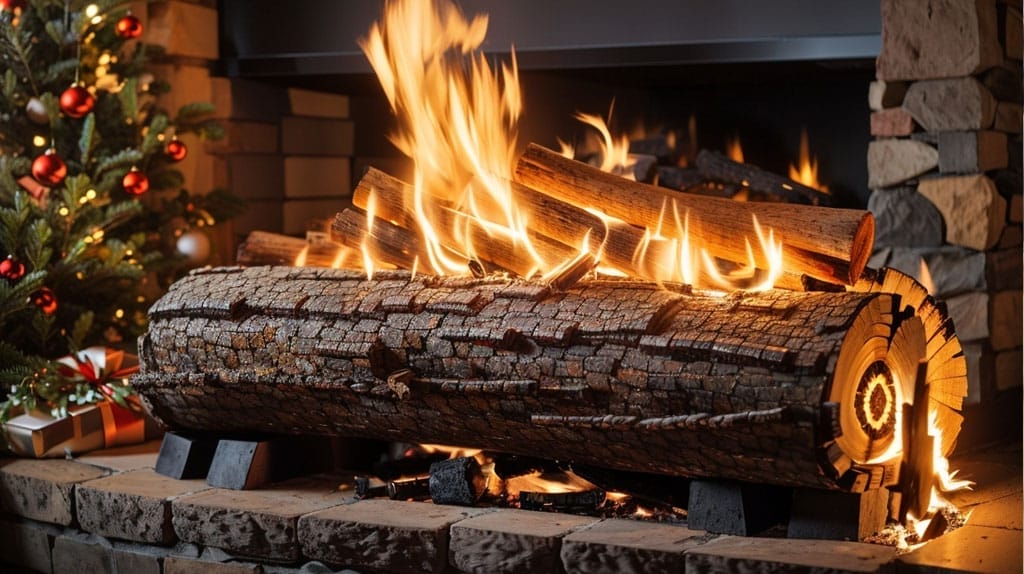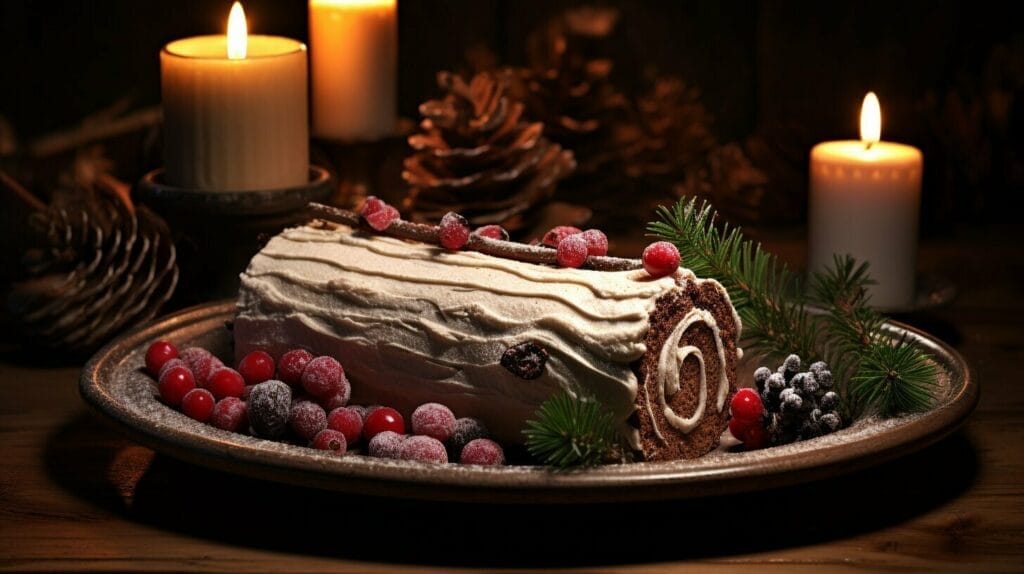Yule Log Tradition – The Legends and History
As the winter chill sets in and the days grow shorter, the Yule Log tradition brings warmth and light into our homes. This beloved custom has a rich history dating back centuries, weaving together pagan and Christian beliefs to create a festive and meaningful celebration.
The Yule Log, also known as the Christmas Log, has deep roots in European folklore and is steeped in symbolic significance. From its use as a symbol of the returning sun in pagan times to its role in Christian celebrations, the Yule Log has played a central role in winter festivities for generations.

In this article, we will explore the history, meaning, and symbolism of the Yule Log tradition. We’ll take a deep dive into the cultural and regional variations of the custom, the Yule Log cake, festive rituals and ceremonies, and ways to keep the tradition alive today.
Quick Overview
- The Yule Log tradition has ancient roots in European folklore and is celebrated during the winter season.
- It has a rich history, weaving together pagan and Christian beliefs to create a festive and meaningful celebration.
- The Yule Log symbolizes warmth, light, and renewal during the darkest time of the year.
- The tradition has diverse regional variations, from fire festivals to the inclusion of the Yule Goat.
- The Yule Log cake, or bûche de noël, has become a beloved Christmas dessert in many cultures.
The Origins of the Yule Log Tradition
As you gather around the fireplace during the winter celebrations, have you ever wondered about the origins of the yule log tradition? This ancient custom dates back to pagan times when communities celebrated the winter solstice, the shortest day of the year. The yule log was a symbol of warmth, light, and life during the darkest time of the year.
The word “yule” comes from the Old Norse word “jol” or “jul,” meaning “wheel” or “cycle.” It represented the cyclical nature of the seasons, with the winter solstice marking the turning point towards longer days and the return of spring.

For pagans, the yule log held great significance as it embodied the spirit of the hearth and the home. It was often made from the largest and most robust tree that could be found and carefully chosen for its ability to burn well throughout the festive season. The yule log was traditionally lit on the eve of the winter solstice and burned for twelve days while families gathered around it.
The yule log tradition was adopted by Christians during the Middle Ages, who saw it as a way to celebrate the birth of Jesus during the Christmas season. The custom of burning the yule log on Christmas Eve continued, but it evolved to include prayers, carols, and special treats.
Today, the yule log tradition remains a cherished part of the winter celebrations, with families and communities coming together to light their own yule log and create warm memories that will last a lifetime.
The Symbolism of the Yule Log
The yule log is deeply rooted in the winter solstice celebrations of ancient cultures, where it represented the light and warmth of the returning sun in the darkest time of the year. The log was traditionally cut from the largest tree in the forest, then dragged home and placed in the hearth, where it was ceremoniously lit. The log was expected to burn for twelve days, representing the twelve months of the year, and was believed to bring good luck and protection to the household during the coming year.
The tradition of the yule log embodies the essence of renewal, rebirth, and the triumph of light over darkness during the winter solstice. The hearth, once the center of the home and social hub of the family, became the focal point of the yule log ceremony, bringing warmth and light to all.

The yule log’s symbolism was also reflected in the charred remains of the log. The ashes were believed to have magical properties and were used for a variety of purposes, including fertilizing the fields and protecting against evil spirits.
Today, the yule log tradition lives on in modern celebrations of the winter holidays. Whether it’s gathering around the fireplace on a cold winter’s night, lighting candles on the menorah, or exchanging gifts with loved ones, the symbolism of the yule log continues to embody the spirit of the season.
Regional Variations of the Yule Log Tradition
While the yule log tradition originated in pagan rituals, it has since evolved and adapted in different cultures throughout history. One of the most notable variations is the adoption of the tradition by Christians as a Christmas ritual.
In many European countries, families light the yule log on Christmas Eve and keep it burning throughout the night. In some places, it is also believed that the charred remains of the log have healing powers and can ward off evil spirits.
Another popular variation is the inclusion of the yule goat, particularly in Nordic countries. The goat, often made of straw, is believed to symbolize fertility, abundance, and good luck. In some places, it is even customary to make goat-shaped cakes as part of the festivities.
Fire festivals are a common variation of the yule log tradition in many parts of the world. In Scotland, for example, the Hogmanay celebration involves a massive bonfire made from a whole tree trunk. In Catalonia, Spain, the Tió de Nadal, or “Christmas log,” is decorated with a hat and other accessories and is beaten by children while singing traditional songs to make it “poop” presents.

Whether you light a traditional yule log by the fireplace or incorporate newer variations in your winter celebrations, the yule log tradition is a testament to the enduring power of symbolism and ritual.
Keeping the Yule Log Tradition Alive Today
Hosting family gatherings around the fire is a great way to bring loved ones together for the holiday season. Fireplaces provide the perfect backdrop for festive activities such as storytelling, singing carols, and enjoying hot cocoa or mulled wine. Of course, no yule log celebration is complete without the traditional burning of the log on Christmas Eve.
Another way to keep the tradition alive is by creating your own yule log ceremony. You can even make your own yule log by selecting a log from your yard or forest, decorating it, and burning it on the night of the winter solstice or on Christmas Eve. The charred remains of the log can even be kept and used as kindling for the following year’s festivities.
While the yule log tradition has evolved over time, it remains an enduring symbol of warmth, light, and renewal during the darkest time of the year. Embracing this tradition during the festive season is a great way to create lasting memories with loved ones and honor the rich history behind the yule log tradition.

The Yule Log Cake – A Delicious Tradition
As we’ve explored, the yule log tradition has a rich history and meaning, but it’s not just about the burning of the log! In many cultures, the yule log has also inspired a delicious festive treat: the yule log cake, or bûche de noël. This dessert is a beloved Christmas tradition in many households.
The yule log cake is typically made of a light sponge cake rolled with buttercream frosting, shaped to resemble a festive yule log. The cake is often decorated with chocolate frosting to resemble bark, meringue mushrooms or holly leaves made of marzipan.
The yule log cake is not only a feast for the eyes but a delightful treat for the taste buds as well. The sponge cake is light and airy, while the buttercream frosting adds a sweet and rich flavor. The chocolate and marzipan decorations provide a festive touch that enhances the joy of the holiday season.
Many families enjoy baking their own yule log cake as part of their Christmas festivities. It’s a fun project to do with children and adds a personal touch to the holiday celebration. You can also find pre-made yule log cakes in bakeries or even in grocery stores, making it easy to enjoy this delightful dessert without the fuss of baking it yourself.
So, if you’re looking to add a sweet and festive touch to your Christmas desserts, consider incorporating the yule log cake into your menu. It’s a delicious tradition that will surely bring joy to your holiday season.

One of the most cherished aspects of the yule log tradition is the ceremonial burning of the log on Christmas Eve. This ritual is believed to bring good luck and protect the home from evil spirits.
To perform the ceremony, the log is decorated with evergreens, holly, and other festive foliage. It is then lit with a piece of the previous year’s log, symbolizing the continuity of the tradition. As the log burns, the family gathers around the fireplace to sing carols, exchange gifts, and celebrate the holiday season.
After the log has burned down, a piece of the charred log is kept as a talisman to protect the home and family until the following year’s festivities. This piece is said to bring good luck, health, and prosperity to the household.
“The Yule log symbolizes the warmth and light of the hearth during the darkest time of the year.”
In some regions, the yule log ceremony is a community event, with large bonfires burning throughout the night. The festivities include music, dancing, and feasting, as the locals celebrate the winter solstice and welcome the longer days ahead.
The yule log tradition has also inspired other festive rituals, such as the German Christmas markets featuring wooden yule log sculptures and the French custom of baking a yule log-shaped cake, known as bûche de noël, during the holiday season.

Whether you participate in a traditional yule log ceremony or simply cozy up by the fireplace with loved ones during the winter holidays, this ancient ritual continues to bring warmth, joy, and togetherness to the festive season.
FAQ
What is the history behind the yule log tradition?
The yule log tradition has its origins in pagan winter celebrations. It was believed to bring light and warmth during the darkest time of the year.
What does the yule log symbolize?
The yule log symbolizes the hearth and is considered a representation of the sun. It signifies renewal and brings light and warmth to the home during the winter solstice.
Are there different variations of the yule log tradition?
Yes, there are regional variations of the yule log tradition. Some cultures have incorporated it into Christmas celebrations, while others include elements like the yule goat or fire festivals.
How can I keep the yule log tradition alive today?
You can keep the yule log tradition alive by incorporating it into your festive season celebrations. Gather around the fireplace with family and friends, light the log, and enjoy the warmth and coziness it brings.
What is a yule log cake?
A yule log cake, also known as bûche de noël, is a delicious dessert traditionally enjoyed during the Christmas season. It is shaped like a log and often decorated with chocolate and festive elements.
Are there any ceremonial aspects associated with the yule log tradition?
Yes, there are ceremonial aspects to the yule log tradition. Lighting the log on Christmas Eve and letting it burn symbolizes the welcoming of light and the burning away of past troubles. Some traditions also preserve a charred piece for the following year’s festivities.




